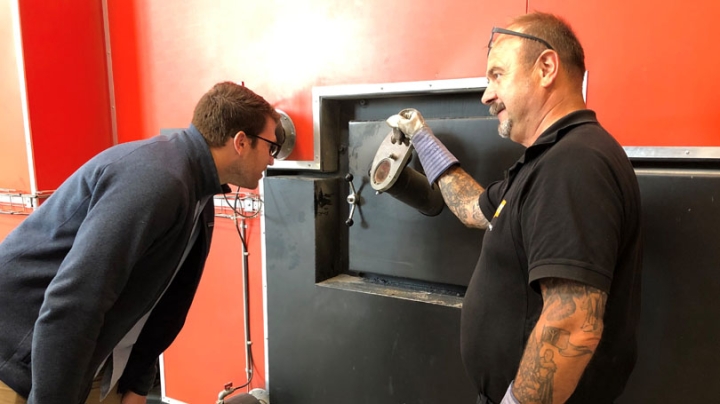Dartmouth is widening its analysis of energy-generation options to heat its campus as the institution continues to move forward with the Dartmouth Green Energy Project, which is aimed at improving energy resiliency, sustainability, and efficiency.
Emerging climate science research in the last year calls for rapid change in energy systems. The time frame to significantly reduce greenhouse gas and carbon emissions has shifted from a decades-long window to a much shorter and more urgent one, requiring major reductions worldwide in emissions in the next two to 10 years.
“We are really, truly open to new ideas that meet these evolving environmental recommendations and can be implemented in our setting,” says Executive Vice President Rick Mills. “We want to widen the net of people we hear from, because we’re not afraid to make sure that what we are doing is right.”
The College’s $200 million energy initiative seeks to meet sustainability and efficiency goals set two years ago by President Philip J. Hanlon ’77 and would replace the College’s aging central steam-heating system—parts of which are more than 100 years old—with a new energy generation and distribution system. The distribution system would use hot water rather than steam to heat campus buildings. A hot-water transmission system at Dartmouth is estimated to be 20 percent more efficient than the current steam system. The change would include replacing steam pipes in more than 110 campus buildings.
There is widespread support for the switch from steam to hot-water heat—which, at more than $150 million, is the largest aspect of the anticipated investment in the Green Energy project. What is still to be decided is how to generate the heat—and cooling in the summer months. The College has investigated construction of a wood biomass plant and, while biomass is still an option, project officials are broadening their review to include a deeper analysis of increased use of technologies that are already in use on campus, including solar, heat pumps, and geothermal energy generation, as well as switching to biofuels in the existing oil-fired heating plant.
Currently, about 2 percent of the College’s energy is generated by solar arrays, with additional solar photovoltaic systems proposed for the rooftops of Dana Hall and the indoor practice facility, both currently under construction, and on the newly expanded rowing facility. Geo-exchange systems, which are powered by electric heat pumps, use the stable ground temperature to heat in winter and cool in summer, and are currently in use in the Fahey and McLane residence halls.
To help broaden the energy recommendations the College is considering, President Hanlon and Mills are convening a Sustainability Board of Advisors to advise the Dartmouth Sustainability Office, which will bring recommendations to Hanlon, Mills, and College trustees. Appointment of this group is among the recommendations in the 2017 Our Green Future report, authored by an interdisciplinary group of faculty, students, and staff who addressed ways for the College to transition to a low-carbon future and increase sustainability and efficiency in energy, waste, food, and other areas.
“We will bring smart, wise, and knowledgeable people to the table to help us make well-informed, science-driven decisions,” says Rosi Kerr ’97, director of the sustainability office. “Improving our energy sustainability and dramatically reducing carbon emissions requires a portfolio of options and will demand new ways of thinking about how we generate, distribute, and use energy. We are working toward not just a more sustainable energy system, but also a more resilient one.”
Kerr says project organizers are planning a public event, a date for which hasn’t yet been set, to discuss progress on the project.
The energy initiative sets out to meet goals—informed by the Our Green Future report—set by Hanlon in 2017. These include reducing greenhouse gas emissions from 2010 levels by 50 percent by 2025 and by 80 percent by 2050; transitioning the heating system from the current No. 6 fuel oil to 50 percent renewable sources by 2025 and 100 percent by 2050; and establishing a better system to distribute energy across campus, improving efficiency by 20 percent.
As the College broadens its study of energy options and invites more voices into the conversation, there will likely be a delay until early 2020 for a request for proposals from companies that could partner with Dartmouth to develop its future energy systems, says Josh Keniston, vice president for institutional projects, who is leading the Green Energy project.
“Despite the delay, Dartmouth is absolutely committed to meeting the goals set in 2017 to drastically reduce our greenhouse gas emissions and to transition to more renewable fuel sources by 2025,” says Keniston. “In addition, planning on how and when to replace steam pipes with hot water piping in our buildings will continue without delay as part of our effort to meet our energy efficiency goals.”
Energy Systems in the U.S. and Abroad
Development of an energy plant that uses wood biomass to generate hot-water heat has been investigated by College officials as a transitional option until non-combustion energy systems can be scaled up to deliver the amount of energy necessary to heat the campus. College staff investigating energy options have traveled to several universities and communities to see various energy systems in use. This fall, town of Hanover staff and volunteers from the community group Sustainable Hanover joined a College delegation on a fact-finding trip to Denmark, a world-leader in setting ambitious low-carbon energy goals and employing highly efficient energy systems to deliver heat.
The group saw biomass plants that use wood and straw, an offshore wind farm, a trash-to-energy plant, and geothermal energy systems. They visited universities and learned about “district heating systems,” which distribute hot-water heat to entire communities, including to most of Copenhagen, the capital city.
“The trip was an interesting framework for thinking about what we are trying to do and confirmed for us that the transition from steam to hot water makes a lot of sense,” says Keniston. “Denmark is considering its path to a no-combustion future through a mix of energy generation systems, which has helped us think about looking at a number of options for Dartmouth.”
Hanover Town Manager Julia Griffin says the Denmark trip has helped inform her community’s work to transition to 100 percent renewable energy for electricity by 2030 and for heating and transportation by 2050.
“Our town-gown trip to Denmark exposed us to just how important it is that strong local government leadership and investment in a community’s transition to renewable energy are key,” she says. “We saw just how prevalent central hot water heating systems are throughout Denmark, and toured some incredibly clean, very low-emission hot-water heating plants, which utilized a variety of heating fuels, set right in the heart of the communities they serve. And we heard from experts who continue to improve the technologies employed to generate heat. As we work with Dartmouth on options, we will also continue to look to Northern Europe for the best advice on this topic.”
Experiential Learning Opportunities
Also making the trip to Denmark were several undergraduate and graduate students who are studying energy and sustainability. Sustainability Office intern Hannah McGrath ’21 says, “The knowledge I gained in Copenhagen will allow me to be even more effective in supporting the College as we try to achieve our sustainability and energy goals. I feel more informed about the complex path lying ahead for Dartmouth and the town of Hanover and hope to carry these insights well beyond graduation into my future work with renewable energy.”
Peter Cahill, Tuck ’20, said a visit to the Middelgrunden offshore wind farm just beyond Copenhagen harbor helped him understand how significant community engagement ultimately led to the success of the wind turbine installation, the development of which had been opposed two decades earlier by people living on the coast.
Camilo Toruno ’20, who is working toward a BA, as well as a BE in engineering at Thayer School of Engineering, said he found that “no single technology, nor set of technologies that currently exist, will solve the problem of climate change. Sustainability is so vast that the final answers are years away, which is encouraging, because sometimes it can seem like all the technological solutions have been developed.”
There is a lot of student interest in energy and the field of climate science—and in understanding Dartmouth’s energy future, says Kerr. Two senior capstone engineering courses investigating Dartmouth’s energy system are currently underway. One is looking at ways to generate head using combustion and non-combustion energy options and the other is investigating adding more solar electricity on campus.
Making sure that students understand energy systems locally and in the wider world has been a core tenent of Kerr’s work with students through the Sustainability Office, with the Green Energy project, and with Sustainable Hanover, of which she is a member.
“Our students are getting hands-on experiential education to help them understand the complexities that exist in making real-world decision about how much energy we use, and where it comes from,” she says.
Susan J. Boutwell can be reached at susan.j.boutwell@dartmouth.edu.


